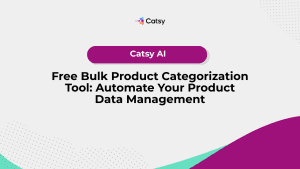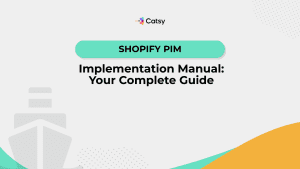Why Adding PIM-HubSpot Integration Beats Shopify's Native Tools for Growing D2C Companies
Shopify Plus Brands
- Ceejay S Teku
- October 2, 2025
- 3:06 am

Table of Contents
What You'll Learn:
- How Shopify Plus’s native product management limitations create bottlenecks for growing D2C lifestyle brands at scale
- The technical reasons why 100-variant limits and forced URL structures impact marketing effectiveness and SEO performance
- Strategic advantages of integrating external PIM systems with HubSpot for sophisticated product data management and automation
- Implementation frameworks that successful D2C brands use to transition from Shopify-native tools to integrated solutions
- ROI calculations and performance metrics that justify the investment in PIM-HubSpot integration for scaling operations
In a conversation I had with a direct to consumer brand founder last week, he told me, “We love Shopify Plus, but we’re drowning in product data chaos. Every time we launch a collection, my marketing team spends three days just organizing product information across different systems.”
Unfortunately, this may sound familiar to you. Like a captain trying to navigate choppy seas with outdated charts, direct to consumer brands may find themselves struggling to steer their growing catalogs through e-commerce channels. These channels are evolving, and trusted tools may no longer be sufficient for the journey.
Shopify Plus handles traffic spikes beautifully, the interface is intuitive, and it scales transaction processing like a dream. But here’s where it gets interesting: the simplicity that makes Shopify Plus appealing early on can become a constraint as your direct to consumer brand matures.
Now, Shopify Plus isn’t broken. It was designed for different problems. When your catalog reaches thousands of variants, automation becomes critical to your profitability. At this point, you’ll begin bumping against architectural decisions that made sense when you were smaller – but not anymore.
So, what’s the solution? Well, we don’t recommend that you abandon Shopify Plus just yet. Instead, try strategically augmenting it with tools that were meant to combat complex data issues.
1. The Growth Trap: Why Shopify Plus Native Tools Start Limiting Scale
Let me paint you a picture of what “hitting the wall” looks like for most growing direct to consumer brands. You’ve scaled past the startup phase, revenue is climbing steadily… then suddenly every product launch feels like pushing through molasses.
The D2C Growth Reality: The numbers tell the complete story. Global e-commerce now accounts for 23 percent of total U.S. retail sales, and that number’s growing twice as fast as overall retail, according to Forrester Research. Growth is great, but with this growth comes a complexity that Shopify’s native architecture wasn’t designed to handle on an enterprise scale.
Critical Shopify Plus Constraints:
Product Variant Bottlenecks:
- After 50,000 variants total, Shopify throttles your uploads to 1,000 per day
- Individual products are limited to 100 variants, max
- Fashion brands launching seasonal collections hit these limits very quickly
SEO Structure Problems:
- Forced URL patterns: /products/item-name and /collections/collection-name
- Migration from other platforms creates redirect nightmares
- No flexibility for custom URL structures that support SEO strategy
Analytics Blind Spots:
- Basic reporting tools are insufficient for sophisticated customer analysis
- Cross-domain tracking problems appear in multi-brand setups
- Limited ability to track complex customer journeys is realized
Marketing Integration Gaps:
- Product data lives separately from marketing automation platforms
- Manual recreation of product information across systems
- Significant time lag between product updates and marketing campaign adjustments
The Compound Effect: These limitations don’t exist in isolation. They compound. Rigid URL structures affect SEO, impacting organic acquisition costs. Variant limits force workarounds that complicate inventory management. Basic analytics create gaps in customer understanding, reducing the efficacy of your marketing.
For direct to consumer brands where customer acquisition costs are rising, these inefficiencies directly impact profitability.
2. Understanding the Technical Limitations of Shopify's Product Management
Let’s dive into the technical architecture creating these constraints. Understanding the “why” behind the limitations of Shopify explains why external integrations become necessary; they’re no longer optional!
Database Architecture Challenges: Shopify’s product database was optimized for simplicity and speed, not complex hierarchical relationships. When you have products with dozens of attributes, seasonal variations, and complex bundling requirements, the flat structure becomes restrictive.
Consider a sustainable clothing brand selling organic cotton t-shirts. In Shopify’s native structure, each size-color-style combination counts toward your 100-variant limit per product. A single design in 5 sizes and 8 colors consumes 40 variants. Add different fits and you’ve hit your limit with one product.
Marketing Data Disconnection: Here’s where the pain really shows up. Shopify’s product data exists separately from your marketing automation platform. Every product launch requires manual recreation of information across email platforms, social media tools, and advertising systems.
With the global e-commerce market expected to reach $6.8 trillion by 2028, manual processes like this become unsustainable. Your marketing teams will spend an increasing amount of time on data entry, not strategy.
Search and Navigation Limitations:
- Basic search functionality relies on product names and descriptions only
- No integration between search results and collection-page filters
- Customers can’t filter search results by specific attributes
- Complex catalogs become difficult to navigate effectively
API Rate Limiting: While Shopify Plus offers higher API limits than standard plans, growing brands still hit throttling when synchronizing with multiple external systems during high-activity periods like product launches.
The Integration Paradox: Shopify’s app ecosystem offers solutions for many limitations, but each app creates new dependencies. More apps can slow down stores and increase monthly costs without solving underlying architectural constraints.
3. PIM-HubSpot Integration: The Strategic Alternative
Rather than forcing Shopify Plus to be something it wasn’t designed to be, successful direct to consumer brands are taking a different approach: specialized systems for specialized functions.
The Architecture of Intelligence: A PIM-HubSpot integration creates an “intelligence layer” above your e-commerce platform. Your PIM system becomes the authoritative source for product information, managing hierarchies, relationships, and your product attributes. HubSpot handles sophisticated customer segmentation and marketing automation. Meanwhile, Shopify Plus continues doing what it does best: processing transactions and handling each of your customer-facing experiences.
Think of it like well-designed software architecture. Each component handles what it’s optimized for, with clean APIs managing communication between systems.
Technical Advantages:
Unlimited Product Complexity:
- Handle thousands of attributes for each product
- Manage complex hierarchical relationships
- Support sophisticated rules for bundling
- No variant limits or structural constraints
Real-Time Marketing Synchronization:
- Product data changes automatically flow to HubSpot
- Customer segments update based on current product attributes
- Email campaigns adjust to inventory and pricing changes
- Automation workflows trigger based on product behavior
Advanced Customer Intelligence: The HubSpot PIM integration enables customer segmentation based on detailed product attributes, purchase history patterns, and behavioral data that Shopify’s native tools can’t match.
SEO and Content Optimization:
- Generate SEO-optimized content automatically
- Manage complex URL structures through headless implementations
- Maintain content consistency across multiple channels
- Support advanced content management needs
Implementation Patterns: The most successful integrations follow a hub-and-spoke model. The PIM system serves as the hub, with Shopify Plus, HubSpot, and other tools as the spokes. Data flows outward to Shopify Plus for e-commerce and HubSpot for marketing automation. You may choose specialized programs for specific functions.
An architectural setup like this one provides “graceful scaling.” As your business grows, you can add new tools and channels without redesigning your entire data infrastructure.
4. Real-World Implementation: How Growing D2C Brands Make the Switch
Let’s walk through what this transition actually looks like.
Phase 1: Assessment and Planning The transition starts with mapping current data flows. Most growing direct to consumer brands discover they’re maintaining product information in four to six different systems, with manual processes connecting them. A recent audit revealed that a team spent 12 hours per week just synchronizing product data across their platforms.
Migration Strategy: Rather than complete replacement, successful implementations use “progressive enhancement.” The PIM system begins by running parallel to existing processes. As teams gain confidence, it can gradually take over data management responsibilities.
Technical Integration Points:
Product Data Synchronization:
- Real-time updates from PIM to Shopify Plus
- Automated inventory and pricing synchronization
- Product relationship mapping across systems
Marketing Automation Integration:
- Rich product attributes flow into HubSpot
- Customer behavior data combines with product preferences
- Automated campaign triggers based on product performance
Analytics and Reporting Consolidation:
- Unified views of product performance and customer preferences
- Cross-platform reporting and analysis
- Operational efficiency tracking
Team Adaptation: Your integration will fundamentally change your daily workflows. Product managers who previously spent hours formatting data for different systems can now focus on strategic decisions. Marketing teams can now create campaigns faster because they have immediate access to current product information and customer insights.
Common Implementation Challenges: Data cleanup usually takes longer than you might expect. Most brands discover inconsistencies in their product data that weren’t easily visible when their data lived in separate systems. Plan for two to three months of data standardization work alongside technical integration.
Success Metrics: Brands will typically see efficiency gains immediately! Product launch timelines are reduced from weeks to days. Marketing campaign creation accelerates significantly. Most importantly, the quality of customer targeting improves because your marketing teams finally have access to the detailed data they need.
5. ROI Analysis: Cost vs. Value in the Long Term
Your leadership is going to want to see the numbers. There’s a good chance your executive leadership will ask you whether your investment is paying for itself. Based on successful implementations, the ROI calculation involves both your direct savings and the compounding revenue improvements you’ll see over time.
Direct Cost Analysis: The integration requires upfront investment in PIM licensing, implementation services, and team training. For most mid-market direct to consumer brands, total first-year costs range from $50,000 to $150,000. This, of course, will depend on your catalog complexity and your requirements for customization.
Hidden Costs of Shopify-Only Operations:
- Manual data management: 10 to 15 hours per week across teams
- Marketing inefficiency: Delayed launches due to content bottlenecks
- Missed opportunities: Limited segmentation reduces campaign effectiveness
- App dependency: Monthly costs for multiple Shopify apps
Revenue Impact Factors:
Faster Time-to-Market: Brands like yours typically reduce product launch timelines by 50 to 70 percent. For seasonal collections where timing is everything, this will directly impact your ability to capture revenue.
Improved Marketing Performance: Access to detailed product attributes and customer behavior enables more precise campaign targeting. Campaign conversion rates often improve 20 to 30 percent within just the first year!
Customer Lifetime Value Enhancement: Better personalization and more relevant product recommendations increase repeat purchase rates and average order values.
Operational Efficiency Gains: Digital asset management integration eliminates the need for manual effort to maintain product imagery and content, especially across multiple platforms. Teams report a 60 to 80 percent reduction in content management overhead.
Long-Term Strategic Value: The integration creates a platform for future growth that can be difficult to quantify, but that becomes increasingly valuable. As customer acquisition costs continue to rise in the direct to consumer space, brands with sophisticated segmentation and personalization capabilities maintain competitive advantages.
Breakeven Timeline: Most brands achieve operational cost savings within 6-12 months through efficiency gains. Revenue improvements from better marketing typically justify the investment within 18 months. Beyond year two, the ROI becomes strongly positive as the platform enables growth that wouldn’t be possible with native tools alone.
Scale Economics: The value proposition improves with scale. Larger product catalogs, more complex customer segments, and higher transaction volumes will all amplify the benefits of an integrated architecture over the native Shopify Plus limitations.
Key Takeaways
- Shopify Plus limitations become growth constraints: Variant limits and URL restrictions create bottlenecks for scaling direct to consumer brands. Native tools can’t address this without expensive workarounds.
- Architectural separation enables specialization: PIM systems excel at complex product data management, HubSpot provides sophisticated marketing automation, and Shopify Plus continues handling transactions. Each system is optimized for its core function.
- Integration drives operational efficiency: Teams spend significantly less time on manual data management and more on strategic activities, with product launch timelines typically reducing 50 to 70 percent.
- Revenue impact compounds over time: Better customer segmentation, faster time-to-market, and improved personalization create cumulative advantages that justify integration investments within 18 months for most mid-market brands.
- Future-proofing through modularity: Integrated architecture reduces platform dependency risk and creates foundations for adding new capabilities as business requirements evolve.
FAQs:
Can we implement PIM-HubSpot integration without disrupting our current Shopify Plus operations?
Absolutely! The best implementations use a parallel approach where the PIM system initially runs alongside existing processes, gradually taking over data management responsibilities. Most brands maintain full operational continuity during the three to six month implementation period.
How does this integration affect our Shopify Plus apps and existing workflows?
Integration typically reduces dependency on Shopify apps since PIM and HubSpot handle many functions previously requiring separate apps. This often results in lower monthly app costs and improved site performance.
What's the minimum catalog size that justifies PIM-HubSpot integration over Shopify native tools?
Brands typically see clear ROI with over 1,000 SKUs or when hitting Shopify’s 100-variant limits on popular products. However, brands with complex product relationships or sophisticated marketing requirements benefit even with smaller catalogs.
How does the integration handle inventory management and order processing?
Inventory data flows from your PIM system to Shopify Plus in real-time. This allows you to maintain accurate stock levels across each of your channels. Order processing remains entirely within Shopify Plus, so there’s no disruption to fulfillment operations.
What happens to our SEO and existing product URLs during implementation?
The integration can maintain existing Shopify URLs for SEO continuity while enabling more flexible URL structures for new products. For brands requiring complete URL control, headless implementations provide maximum flexibility while preserving e-commerce functionality.





